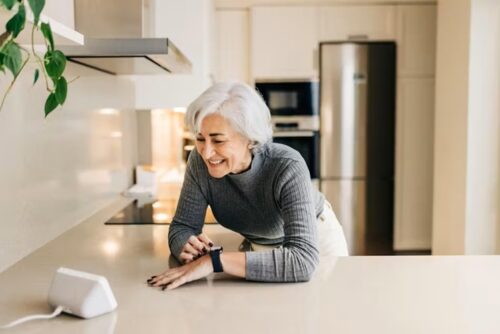9.13.24 – SIW – Elizabeth Parks

Integrators can provide smart home and wearable devices that appeal to a range of support for seniors and their caregivers
Family caregivers and older adults face numerous challenges in managing health and daily activities. Technology offers promising solutions to ease their burdens and Parks Associates’ ongoing research of the consumer tech markets highlights these opportunities.
Innovations such as smart home devices, wearable health monitors, and telehealth services are transforming caregiving, providing real-time assistance and remote monitoring. These tech solutions enhance the quality of life for older individuals and support caregivers in delivering efficient and effective care.
Fragmentation is a key challenge in the independent living solutions market, as it is in the smart home market. Many family caregivers remain unfamiliar and uncertain as to which solutions are available, what they have to offer, and where they are available. This is where a skilled integrator can capitalize.
According to research, 87% of wearables purchase intenders report that they are willing to pay more for tested medical features, and 84% of intenders report they are willing to pay more for tested wellness features.
Smart home and wearables devices present a valuable opportunity to help people live safely and independently while ensuring their loved ones remain aware of their well-being. By providing products that enable real-time assistance and emergency alerts, businesses can address a critical need in a growing market of seniors and caretakers. Additionally, offering services that integrate remote monitoring and control further enhances the appeal of these solutions, ensuring a balance between support and privacy.
Seniors: Monitoring and Safety Solutions
Smart home devices include many different technologies and services that support senior independence and family caregivers’ need for monitoring and safety solutions. These include video doorbells, smart door locks, smart gas/smoke detectors, smart lighting solutions, and wearables that provide emergency response services are now emerging as a new category.
There are many different applications and services for independent living using smart home devices:
Smart Security Systems: Automated locks, doorbell cameras, and motion sensors provide context and video verification on the environment, as well as control of access.
Health Monitoring Devices: Wearable devices and smart scales track vital signs, medication reminders, and emergency alerts.
Voice-Activated Assistants: Devices like Amazon Alexa and Google Home provide hands-free control of home appliances, reminders, and emergency calls.
Automated Lighting and Climate Control: Smart lights and thermostats that adjust based on user preferences and presence, improving comfort, safety, and energy efficiency.
Smart Appliances: Refrigerators, ovens, and other appliances can be controlled remotely and send alerts for maintenance and safety.
Fall Detection Sensors: Devices can detect falls and automatically notify caregivers or emergency services.
Remote Monitoring Systems: Cameras and sensors allow family members and caregivers to monitor the well-being of older adults from afar.
In addition to independent living solutions, wearables are emerging as a key category for safety and security for seniors. For U.S. households with intentions to purchase a wearable, there is a willingness to pay for medical and wellness features.
According to research, 87% of wearables purchase intenders report that they are willing to pay more for tested medical features, and 84% of intenders report they are willing to pay more for tested wellness features.
Wearables makers must focus marketing strategies on the diverse applications of wearables, highlighting health and wellness features for fitness tracker users, and emphasizing versatile, non-fitness functionalities for smartwatch users.
Connected Devices and Emergency Services
The integration of advanced sensors in wearables and safety and security devices and systems is driving the growth of real-time emergency assistance services. These devices offer continuous monitoring and instant notifications to emergency contacts, fueling market expansion for integrated safety solutions.
Parks Associates research shows that family caregivers value devices with features such as fall detection, alerts in case of fire/smoke/gas, voice calling solutions, and alerts if stoves and burners are left on have universal appeal regardless of where the senior is living.
Monitoring specifically is a feature that appeals to more than a third of family caregivers with a loved one living alone. Family caregivers with seniors living in their own homes see greater value in security cameras and video doorbell solutions, which have a high overlap with home security functionalities.
In addition to smart home devices as safety and security for loved ones, one in five households use a device or app that can automatically call for help in case of an emergency.
The reasons for adopting an emergency call solution vary. Peace of mind is the most reported reason for adopting an emergency calling solution. Of those aged 65+, 20% selected “other” as a reason for using their device, with many reporting that it was a default feature that came with their device.
This article originally appeared in the September 2024 issue of Security Business magazine. Don’t forget to mention Security Business magazine on LinkedIn and @SecBusinessMag on Twitter if you share it.
This is an excerpt from Parks Associates’ library of research. For more information visit www.parksassociates.com.

About the Author
Elizabeth Parks
Elizabeth Parks is the President of market research firm Parks Associates. For more information, visit www.parksassociates.com
